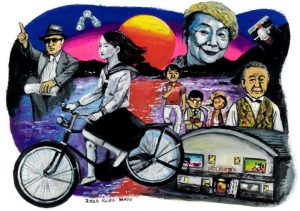Hiroshima and Film, Part 1: Chigumi Obayashi – Script writer and culinary expert
Jul. 27, 2024
“Umibe no Eigakan – Kinema no Tamatebako” Director: Nobuhiko Obayashi (Released in 2020)
The power to change the future is in all of us
I now have a film script in my hand that my father left me. The script is filled with his handwritten notes. The title of the film is “Umibe no Eigakan – Kinema no Tamatebako (Movie theater by the seashore – Treasure Box of Cinema).” Yes, my father is the film director Nobuhiko Obayashi from Onomichi City.
The story goes like this: Three young men go to Setouchi Cinema, a movie theater which is about to be closed down, for its last all-night screening of the movie “Nihon no Senso Eiga Daitokushu (A great collection of Japanese war movies).” Then the three men step into the screen, and run around the Boshin Civil War, the Sino-Japanese War, the Battle of Okinawa, and Hiroshima city just before the atomic bombing. Can they really save heroines who are at the mercy of war?
The film tells dense stories that span the above-mentioned periods, across all film genres, including musicals, period dramas, SF, fantasy, westerns, love & romance. It also incorporates the history of film, from 8-mm and silent films my father saw in his childhood to full color and digital films.
It would be impossible to put all this content into a single film… As the film adds everything, it is not surprising people might think this way. But strangely enough, it is a work people can enjoy as a pure entertainment by simply losing themselves in it.
And yet, every single scene in the film is filled with the message that my father always said: “I don’t want war.” My father, who was born in Onomichi, escaped the damage caused by the atomic bomb, but in his childhood, he saw many injured people coming along the railway tracks from Hiroshima. I think that what was embedded in his memory probably made him feel that he hated war. This feeling, I believe, is the will of my father, who lived through the Pacific War, to young people living in today’s Japan, which is said to be in a new pre-war period.
It is human beings who have invented “happy endings” in films that cannot exist in the real world. However, if we believe in the “happy endings” of films like this film, then, perhaps, one day, we may be able to bring peace closer to us. The film cannot change the “past,” but it has the power to change the “future.”
My father wrote some words just before he died, in response to my request “Please leave a message to those who will watch this film.” His handwriting is shaky due to terminal cancer. But the pressure he applied to the pen was strong as if he had written them, chipping away his soul. Each character was filled with his thoughts and feelings that he had to clearly convey this at least. “Hey. Shall we try to change our future through films?”
This was the last message from my father.
****
In this series, the Chugoku Shimbun will ask a film-loving writer to choose one film and introduce highlights and their memories about the film they have selected. We will post them from time to time.
Information on the film
Japan / 179 min / “Umibe no Eigakan – Kinema no Tamatebako” Production Committee
[Script] Nobuhiko Obayashi, Tadashi Naito, Kazuya Konaka [Cinematography] Kugyo Sanbongi [Music] Kosuke Yamashita [Production cooperation] Kyoko Obayashi
[Performer] Takuro Atsuki, Takahito Hosoyamada, Yoshihiko Hosoda, Rei Yoshida, Riko Narumi, Wakana Yamazaki, Takako Tokiwa, Yukihiro Takahashi, Nenji Kobayashi
Chigumi Obayashi
Born in 1964 in Tokyo. From an early age, she grew up on the sets where Obayashi’s movies were produced and has written a lot about film. She also lectures on table manners. She directed “Hyakunen Gohan (100-year meal)” in 2013, and wrote “Mirai e Tsunagu Shoku no Baton (Baton of Food Connected to the Future”), etc.
Hato
Born in 1981 in Otake City. Her real name is Keiko Hata. She creates a wide range of formative arts, including painting, graphic design, stop-motion animation, and theatrical art, in her own world where nostalgia, adorableness, and weirdness coexist.
(Originally published on July 27, 2024)








